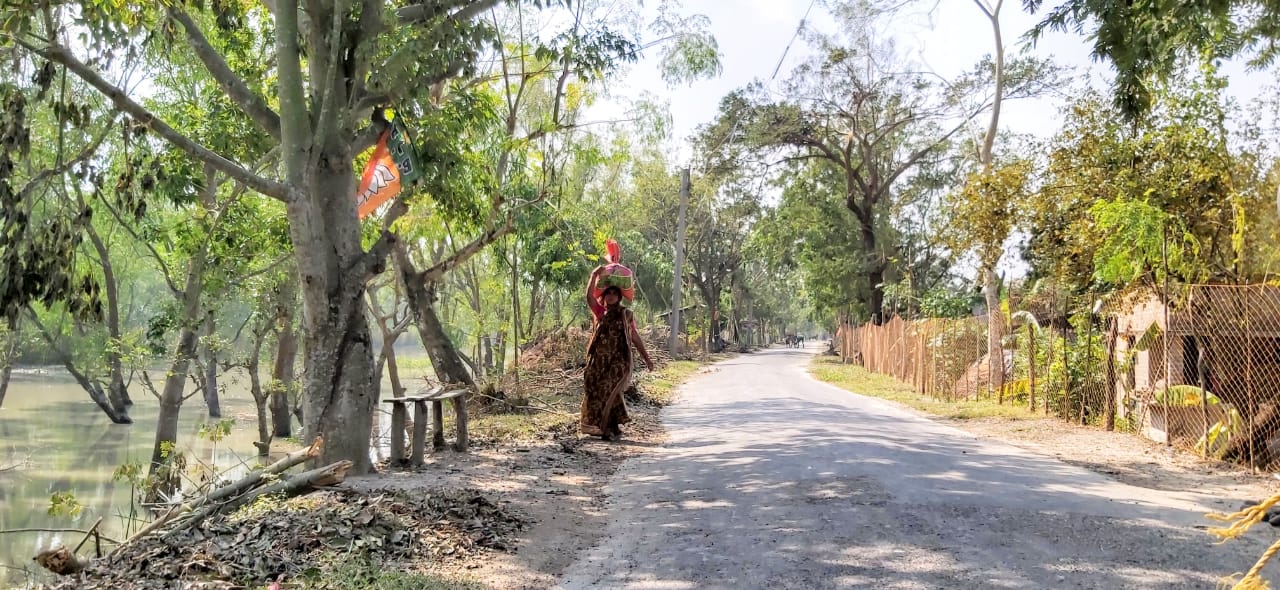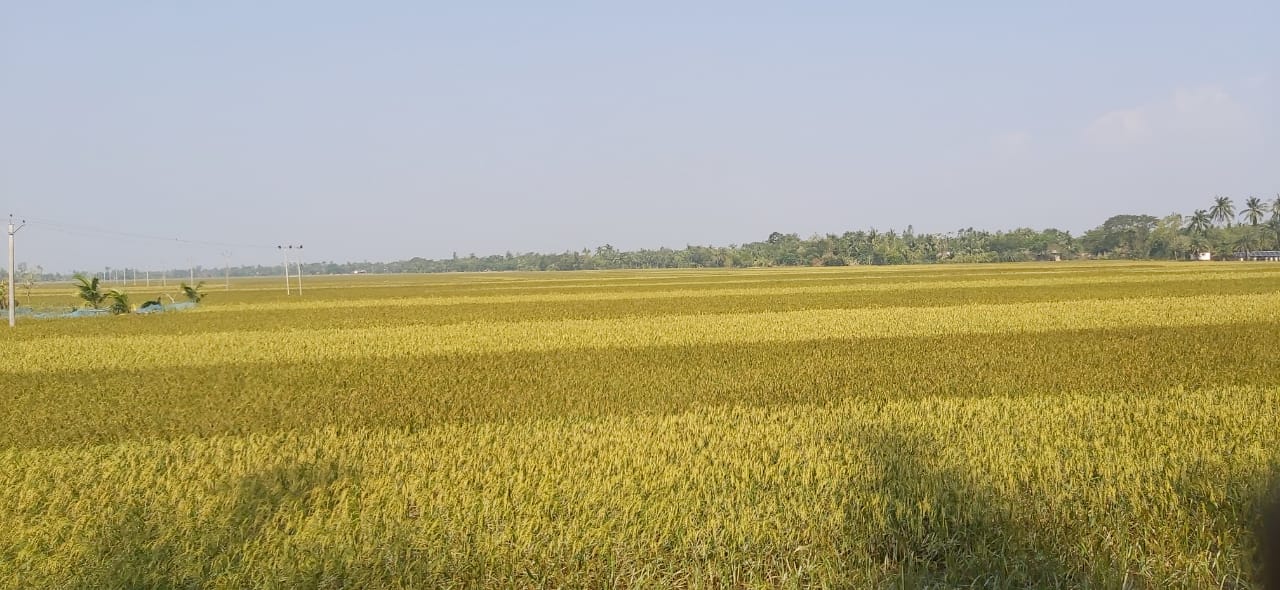Where tigers swim and roots stand up
People in this delta, second only to the Amazonian one, struggle for a living caught between furious storms and a rising sea. The saving grace, mangroves, is fast disappearing.
A long-dreamt journey to the Sundarbans ended up, not with sightings of the ‘cunning’ tigers but adventures of another kind. It was a trip where hurdles leapt across our path — on rail track, road and waterway, to deter us. But for sure, we did see ‘a tiger’. More importantly, we got to see how people eke out a living, battered by cyclones and a creeping sea.
Slowly as we left Kolkatta and the traffic behind, the roads narrowed with shops on both sides and people everywhere. The TT we were travelling by from Shantiniketan had picked up speed and was now a galloping bullock cart, bumping and evading potholes and people. We reached Canning, a small town situated on the tip of Matla river and called the Gateway of Sundarbans by 5 pm. Dusk had dropped its veils and the green paddy fields on either side were totally hidden from the eye. At Chunakali, a village, our vehicle came to a stop. Ahead as far as we could see were vehicles lined up and a lot of noise from people walking by. It turned out that a fully loaded lorry had got stuck in the slush and it would take 3-4 hours to pull it out.
An occasional cart or a ‘toto’ passed from the opposite side but that apart, there were only the milling crowds on foot, talking and walking in both directions. It was an assortment of people — those returning after a day’s work, few dressed up festively for some occasion, and some with a lot of luggage, en route or returning from some other place. Having alighted from the buses or jeeps, they were legging it, having seen the futility of waiting. The scene was reminiscent of Partition (as seen on celluloid) with the steady flow of people from both sides.
Luckily, by 7 pm the lorry was emptied and moved out of the way with some minor losses by way of a wall of a tea shop broken, etc. Local samaritans had come together to lend muscle. Call it goodwill or a welcome break from the monotonous game of cards or dice indulged along the roadsides.

A land of canals, creeks and the river as it meets the sea
With renewed vigour, our TT now sped through the narrow road heading straight into the Bay of Bengal. At 8 pm we were at the Gadkali boat launch point. Displayed on an arch above the entrance were the thrill-evoking words, ‘Welcome to the only mangrove tiger land in the world, Sunderban Tiger Reserve’. The fatigue of the journey evaporated, as snatches of Amitav Ghosh’s Hungry Tide came to mind.
Moonlight ride
Awaiting us was a boat ride on the wide river with the moon riding high above. The peaceful waters reflecting the moonlight, tree cover on the distant shores on both sides with occasional lights twinkling through, and a cool breeze, lulled us. Tea was served with biscuits. By 9.30 we had reached our destination, Sundarban Tiger Safari, a resort near Sonagah village in the Gosaba island.
Getting down was a bit of a challenge. Slush-filled narrow steps had to be negotiated before getting on to a path that was barely a feet wide and falling down on either side to pure slush. Fortunately it was dark and it was only the next day at dawn that we saw the ledge we had walked on.
Dinner was a late event that day but the journey had provided enough grist for chatter.
Dawn and the sun were up and about by 5 am, something we had realised on arriving in West Bengal. Evenings go dark by 5, often warranting a check on the wrist watch.
The resort is manned by locals, with two elderly men managing the show well. Simple but delicious food helped our taste buds that craved for some spice after the sweet-tinged food of the last couple of days.

The dawn exposes the mudflats as the waters recede
At 7.30 am we left on the ferry for a day-long cruise along the Datta and Bidyadhari rivers. It took some GPS convincing for us to accept we were cruising on rivers and not the sea, which was still a good 60-100 kms away. The river stretched for couple of kilometres on both sides and our guide, Moloy, supplied information on the region and its inhabitants.
The ‘cunning’ tiger
One side of the mangroves was part of social forestry and housed villages and people, while the other side was the tiger reserve housing not only the tiger but estuarine crocodiles, water monitor lizard, Gangetic dolphin, Olive Ridley turtle and other species. “Yaha ka tiger is totally different from tigers in other places. They are not part of the census figures as no one has been able to count them. They are very adaptable and very cunning,” he told the audience, all ears. (In fact, scientific studies have shown that the skulls and body weight of the tiger here indicate they are a distinct subspecies that has evolved to the land, making the region a priority area for tiger conservation.)
This is the only mangrove forest in the world where tigers are found, he emphasised. What Moloy did not know is that a study has predicted that the Asian tiger will disappear from this region in 50 years, given the pressures of development and climate change. The last census in 2020-21 using camera traps has shown the presence of around 100 tigers. Among the animals that have gone extinct from the region are the water buffalo, swamp deer, Javan rhino, gharial, great Indian one-horned rhino and chitra turtle, according to a study cited by WWF.
The 10,000 sq km wide Sundarbans delta is spread across India and Bangladesh with only 40% (4262 sq km) in India. Given the unique biosphere it represents, it is a World Heritage place, said Moloy with well-suppressed pride. According to Sundarban National Park, the Sundarbans on the Indian side has 102 islands, out of which 54 are inhabited. At a mean elevation of 2 metres above sea-level, the mangrove forests here face threat of inundation. The dominant Sundari species of mangroves is expected to give way to other salt-tolerant species as the water gets more saline.
Fed mainly by three major rivers – Ganga, Brahmaputra and Meghana — the region sees semi-diurnal tides (high and low tides daily with the water rising by almost 5-6 feet). Early morning reveals the gleaming blackish mudflats exposed by the receding water. Locals negotiate this on foot, carefully moving foot after foot laboriously. Given the tidal flows that can submerge the whole forests every day, the mangroves survive with special roots that pierce out of the mud and stand, enabling them to breathe.

Mangroves, the vanishing natural embankment
Jadavpur University had thrown up an idea to harness 100 MW of tidal energy, terming it as reliable and steady and with no impact on the environment. Recent research points to detrimental effects of man trying to control the tides, mining the earth for brickmaking and landfilling, and geophysical changes like a shift in the delta mouth leaving a sediment deficient on the Indian side. Not to forget climate change, which Ghosh has likened to slow violence!
Sinking land
Four islands — Bedford, Lohachara, Kabasgadi, and Suparibhanga — have vanished due to rising sea levels in the last 25 years. Lohachara was the world’s first inhabited island to be submerged in 2006.
NASA Landsat satellite imagery reveals a sea level rise of approximately 3 centimeters a year in the past two decades. In this period the Sundarbans has also lost 110 sq kms of mangroves. A study by the Proceedings of the National Academy of Sciences of the US, or PNAS, estimated that the sea level in the area would rise by 1.3 metres by 2100.
After lunch on the boat, we arrived at a village Shamshernagar close to the Bangladesh border. Bundled off in two totos, we passed through green paddy fields on one side and mangroves on the other. This is the closest the tiger gets to human habitation, informed Moloy.
Everywhere were signs of the cyclone Bulbul that had wreaked havoc in the delta. Power lines were still to be restored. Embankments were breached in some places by the ‘hungry tide’. Somehow the fragile mud houses seem to have withstood the fury of so many cyclones, or perhaps these were the re-cycled versions. Some with tin roofs, many with thatched ones, the dwellings with their doors built of wooden sticks made one wonder how secure the inhabitants were from the unpredictable weather. The cyclones are more frequent and intense than before, says a fisherman, a direct fall-out of climate change.

An arduous life
Most of the poor households see the women go to the riverbanks at dawn to net tiger prawn seedlings which fetch between Rs 200-300 per 1000 seedlings. An arduous task which requires them to be in the saline waters for over 3 hours just fetches enough to buy some essentials, and a lot of skin infections. Ideally, this is done in the months of April-May but women end up netting the hair-sized seedlings in the saline waters almost daily, informs Moloy.
The seedlings end up in some of the towns like Canning where they are harvested in brackish water for three months and then sold. The shrimp breed only in the wild under cover of mangroves and that is where the efforts of the women pay off, for the trade fetching Rs 800-1000 per kg in market. However, this practice has been affecting the growth of mangroves as well as other fish species, say environmentalists.
The Wall
Our guide pointed out the BSF outpost beyond which the Bangladesh part of the Sundarbans lies. Part of a tourist itinerary, this was however not what we had come for, but it became evident how porous the borders here are. Soon we were back on the boat. To persistent queries on the tiger, Moloy regaled us with tales of tigers that can swim the whole span of 3-5 kms from the reserve to the villages on the other side. On some persuasion, he asked the boat to be taken closer to the reserve side of the waters from where we could get a better picture of the mangroves. What struck the eye was a yellow fencing around the whole region, stretching up to a good 6-7 feet height. All hopes of seeing a tiger were quashed. The nylon fence was put up in 2014 to control human-wildlife interactions and since then, the instances of tigers straying out have dropped drastically, said Moloy.
However, villagers often break the fence to get into the forest for honey, etc while fishing on the tiger reserve side also lures people to the forest, inviting trouble. Two days after our visit, tourists were lucky to see a tiger that had found its way through the fence and was seen close to the water.
We were lucky to see two water monitor lizards, some mud skippers (amphibian fish that dance on the mud), a rare kingfisher, large heron and two adjutant storks along the water side.

Paddy cultivated in few large patches.
As we returned to our resort, we dropped in on an adjacent village which our guide informed us belonged to Adivasis of Chattisgarh brought in just after Independence, for their hardiness and strength. Now integrated with the local culture, they live off the land. Given that the water in the river can be salty, people build small bunds close to their homes in which they catch and harvest rainwater for all purposes. Cultivating rice is done only once during the monsoons. The rural part of Bengal is rife with such ponds and rice mill chimneys. Small-built goats were all over the place at Sundarbans, and most of them looked pregnant. Farming paddy and rearing fish in ponds are some ways of earning income in these areas.
Lo! The tiger
A treat awaited us before dinner. We were to finally see the tiger.
A local drama troupe, Lakshminarayan Opera, from the Sonagah village was going to perform a play based on ‘Boner ma Bonbibi’ (the Mother Goddess of the Forests). Bonbibi is believed to be the guardian spirit of Sundarbans who protects villagers from the tiger.
https://studio.youtube.com/video/-TQ9Xny-ELI/edit
The story unfolded of how a young boy who lost his father is sent to work with his uncle after much pleading with the mother, who fears the tiger. Involving the fisherfolk and honey collectors, the play went on to show how the lives of the people are intertwined with the forest and the tiger, and how the goddess protects them, as long as they do not turn greedy. Also woven into the plot portrayed was the mythological story of the evil landlord who turned into a tiger and preyed on the people. The prayers of the people are heard and Bonbibi, daughter of a Sufi saint is sent by god to kill the landlord-tiger. Bonbibi forgives the tiger and grants her protection to anyone who worships her.
Now, none of us understood a word of the script but the power-packed, intense performances moved us nonetheless. The mother of the child shed real tears without the need for glycerine. The earnestness of the players brought tears to our eyes. Every prop used on the sparse stage was well displayed, from the beehive to the burning fire. The village troupe came complete with its electrician who fitted moving, colourful lights on stage!
The play also afforded us a glimpse of the tiger we had travelled miles to see, albeit a clothed version.
All farmers or fishermen, these were a group of people who used their art to spread the message of co-existence and faith. Both Hindus and Muslims worship the goddess under different names.
At the mercy of tides
Before the sun dawned the next day, we left the place at 4.30 am. But due to low tide, the boat couldn’t proceed after some distance for fear of running aground on sand. We had to shift to a smaller boat and that was quite some adventure for the bunch of us who couldn’t possibly swim in one inch of water! Standing with our weights distributed across the boat, we waltzed to the jetty. But there again was a problem. The high tide had piled up the slush generously on the steps and even the locals feared to tread them. The boatman and his friends had a few tiring moments of fetching water from the river and clearing the steps. We waited, watching the sun rise.

To say life here for the 4.5 million people is tough would be an understatement. Yet, the inhabitants do not want to leave.
But, it was time for us to bid goodbye to the ‘beautiful forests’ and sit back in our ‘cart’ which proceeded to speed along the road, so that we could catch the train at 10.50 am. The green fields were now on full display. The rest is history as they say. Traffic held back, bridges held on and Howrah station looked quite deserted.
By Jaya
